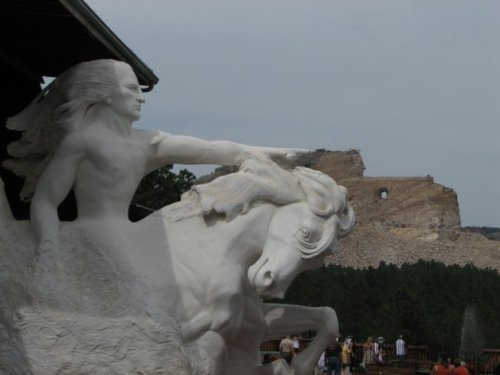
Above: A model of the Crazy Horse sculpture with the monument in the background.
Crazy Horse was more than a figure; he was a symbol of resistance and of courage for the Lakota people who called South Dakota home. So it’s fitting that the hills of the region will one day be decorated with a large figure of this legendary man. In hills already famous for its four large busts of presidents that look down from Mount Rushmore, this statue of Crazy Horse will be much larger than the famed Rushmore sculptures. Whereas the heads of Washington, Jefferson, Lincoln and Roosevelt are 18m tall, the head of Crazy Horse alone is 27metres in height. The overall dimensions are 195 metres wide and 172 metres high. When finished, it will be the world’s largest sculpture. The strange thing is that it is not certain that the sculpture will ever be completed. It has been under construction from 1948 and its creation is one hell of a story of perseverance.
The story of Crazy Horse is linked to that of sculptor Korczak Ziolkowski, who was commissioned by Chief Henry Standing Bear in 1939 to build a statue that would show “that the red man has great heroes, too”. While other areas had better stone for sculpting, the Sioux leaders decided that it would be more appropriate to carve in the sacred Black Hills, an insistence that has led to some controversy in later times. Ziolkowski started work in 1948, working on it until his death in 1982. At the time of his death, it looked to a layperson that no real progress had been done, although a lot of blasting had happened to clear the way for more fine-scale sculpting. Perhaps to give the project a recognizable face, Crazy Horse’s head was finished in 1998 (something that Ziolkowski didn’t want to happen but it does make the project much more marketable). Reading about Ziolkowski, you get the impression that the project consumed him. He worked tirelessly on it and is buried in a tomb at the base of the mountain. His wife and ten children were actively involved in the sculpture. After his death, his wife acts as the director and seven of his ten children are actively involved in either the carving or in the Crazy Horse Memorial Foundation.
Part of the slowness in completing the sculpture has been a lack of funds. Federal funding grants of 10 million dollars have been turned down on two occasions due to fears that acceptance of grants would also mean acceptance of conditions that might dilute the education and cultural goals of the Foundation. Other than the sculpture, there are plans for a Native American University to be established on the grounds (the university started last year), for cultural centres to be established and maintained and for a large museum celebrating Native American heritage to be opened. Money has been raised through visitor entrance fees and through donations. Machinery has been donated to the memorial for use on the project.
While its attentions would appear noble, there has been controversy over the project. There are no known photos of Crazy Horse and it seems as if photography was something he seemed to take measures to avoid. Therefore, is producing a massive likeness of him honouring his legacy and wishes? Of course, without a photograph, can we even be sure that it is his likeness? His body was deliberately buried in a way that his grave could not be found (there have been at least four locations identified as potentially being his grave). Is this sculpture a giant tombstone? Again, is this against the wishes of the man who wished to remain anonymous in death? Proponents of the monument would argue that Crazy Horse was chosen as a representative of all Native Americans and that it acts as a metaphoric tribute to all Native Americans, especially to those who died protecting their land, lifestyle and culture from the advances of Western Civilization.
I visited the memorial in 2008 and it was already an impressive sight. The museum and craft shops were up and running and work on the university had begun. A model of the sculpture stands outside, giving the visitor an impression of how impressive it will be when finished (a trip back to see it when it is finally finished is a must do). Crazy Horse sits on his horse with a figure pointing out over the Black Hills, indicating the lands he talks about in his famous quote “my lands are where my dead lie buried.” At night, you can go to see a laser show that documents a story about the Native American people and about their grievances of how they have been affected over the last 500 years of interaction with the outside world. It makes for an entertaining hour, although surprisingly given the content of the show, it ends with a rendition of “Proud to be an American”. (This was probably inevitable, given the amount of times I heard this song played in my trip around the States). It seemed strange to me that these proud people who have had land taken from them, have been vilified, suffered great losses and breeches of trust would choose to end a show highlighting their culture with this song. I guess it shows that even when wronged, people still have the right to express their patriotism.

No comments:
Post a Comment